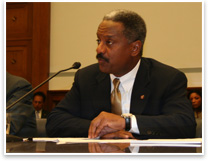 The Next World’s Tallest Building? It’s Anybody’s Guess The Next World’s Tallest Building? It’s Anybody’s Guess
The event horizon of high-rise development in emerging nations is rapidly accelerating to an unpredictable pace. In such places, where construction is cheap and real estate on par with top American markets, builders can afford to splurge on ambitious design and be appropriately rewarded. This boom is capturing the same desires and aspirations that fueled America’s 20th century skyscraper dominance, albeit with an emphasis on personal ownership and mixed-use design. 
 FROM AIA GOVERNMENT ADVOCACY FROM AIA GOVERNMENT ADVOCACY
AIA Leadership Pushes Congress for Carbon Neutrality:
AIA President RK Stewart, FAIA, and AIA President-elect Marshall E. Purnell, FAIA, testified last week before two committees of the U.S. House of Representatives to encourage the federal government to adopt the AIA’s 2030 goals for federal buildings. Stewart and Purnell urged Congress to set energy reduction targets for new federal buildings and buildings undergoing major renovations. If the AIA-recommended policies are adopted, they said, all federal agencies will be required to reduce significantly the amount of fossil fuel-generated energy used in the next generation of federal buildings, resulting in carbon-neutral federal buildings by the year 2030. 
 Clinton Foundation Announces Green Building Initiative: Clinton Foundation Announces Green Building Initiative:
The Clinton Foundation recently announced a landmark partnership with 16 cities to cut carbon emissions through the renovation of city-owned buildings. “Climate change is a global problem that requires local action,” noted Bill Clinton in a press release on the program. The newly developed Energy Efficiency Building Retrofit Program will bring cities, the largest energy services companies, and five major global financial institutions together to reduce energy use in existing public buildings by 20–50 percent. 
Building Design Leaders Unite on Energy Reduction Targets:
To reduce the building design industry’s impact on the environment, key leaders in that sector are collaborating to establish carbon-neutral buildings by the year 2030. The AIA; the American Society of Heating, Refrigerating and Air-Conditioning Engineers (ASHRAE); Architecture 2030; the Illuminating Engineering Society of North America (IESNA); and the U.S. Green Building Council (USGBC), supported by representatives of the U.S. Department of Energy (DOE), finalized an agreement of understanding May 4 establishing a common starting point and a goal of net zero energy buildings. 
Summit Releases Findings on Culture, Agendas for Architecture Research
A new site on AIA.org presents the key findings of the AIA 2007 Board Knowledge Community Research Summit, held March 23–24 in Seattle. A group of 39 practitioners and educators explored the culture of research and drivers of change to identify emerging research agendas in architecture and elevate the importance of research in the profession. The new Web site offers both videos and transcripts of the two keynote presentations, written and graphic statements from the summit’s five-person panel discussion, and the results of breakout sessions that developed agendas for social, technological, environmental, cultural, organizational, and design research.  |
 The Next World’s Tallest Building? It’s Anybody’s Guess
The Next World’s Tallest Building? It’s Anybody’s Guess
 FROM AIA GOVERNMENT ADVOCACY
FROM AIA GOVERNMENT ADVOCACY Clinton Foundation Announces Green Building Initiative:
Clinton Foundation Announces Green Building Initiative: